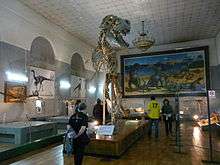Mongolian Natural History Museum
 | |
| Established | 1924 (as the National Museum) |
|---|---|
| Type | Natural History |
| Visitors | ca. 80,000 annually |
| Website | www.naturemuseum.mn (in Mongolian) |
The Mongolian Natural History Museum (Mongolian: Байгалийн түүхийн музей) is a repository and research institution located in Ulaanbaatar, Mongolia. The museum was previously known as the Mongolian National Museum or State Central Museum. This change in name has often led to confusion with Ulaanbaatar's other preeminent museum, the National Museum of Mongolia. Although the two museums are located quite close to one another, they contain very different exhibits. The Mongolian National Museum focuses on the archaeology and history of Mongolia, while the Mongolian Natural History Museum is concerned primarily with the flora, fauna, geology and natural history of the country.
The museum includes Departments of Geology, Geography, Flora and Fauna, Paleontology, and Anthropology encompassing the natural history of Mongolia. The museum's holdings include more than 6000 specimens, 45% of which are on permanent public display.
The museum is particularly well known for its dinosaur and other paleontological exhibits, among which the most notable are a nearly complete skeleton of a late Cretaceous Tarbosaurus tyrannosaurid and broadly contemporaneous nests of Protoceratops eggs.
History

The Museum was established in 1924 as the National Museum (Mongolian: Үндэсний музей). In 1940-1941 the museum became known as the Rural Research Museum' (Mongolian: Орон нутаг судлах музей) and in 1956 as the State Central Museum (Mongolian: Улсын төв музей). The museum received its current designation after the 1991 democratic revolution.
The current building was erected in 1953, and was deemed to be highly susceptible to natural disasters such as earthquakes in a study made in 2013. It was scheduled to be replaced by a new building, with budgeting planned to start in 2014.[1]
References
External links
- Official site (in Mongolian)